An Analysis of Surface, Deep, and Strategic Learning Approaches
VerifiedAdded on 2021/06/17
|7
|1901
|112
Essay
AI Summary
This essay examines different learning approaches employed by first-year students in higher education, focusing on surface and deep learning. It explores why students often prefer surface learning, which emphasizes memorization and minimal effort, and discusses the associated drawbacks, such a...
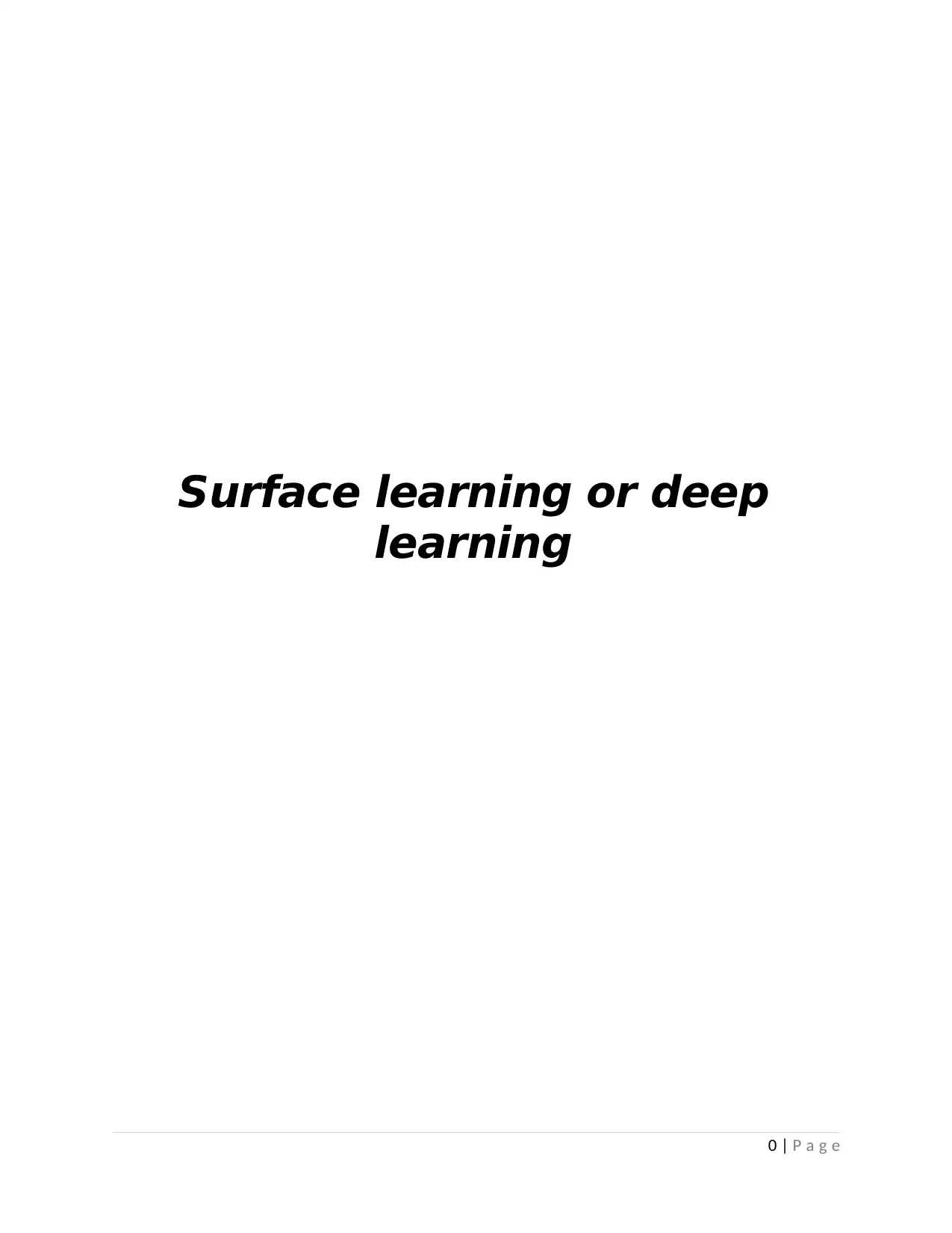
Surface learning or deep
learning
0 | P a g e
learning
0 | P a g e
Paraphrase This Document
Need a fresh take? Get an instant paraphrase of this document with our AI Paraphraser
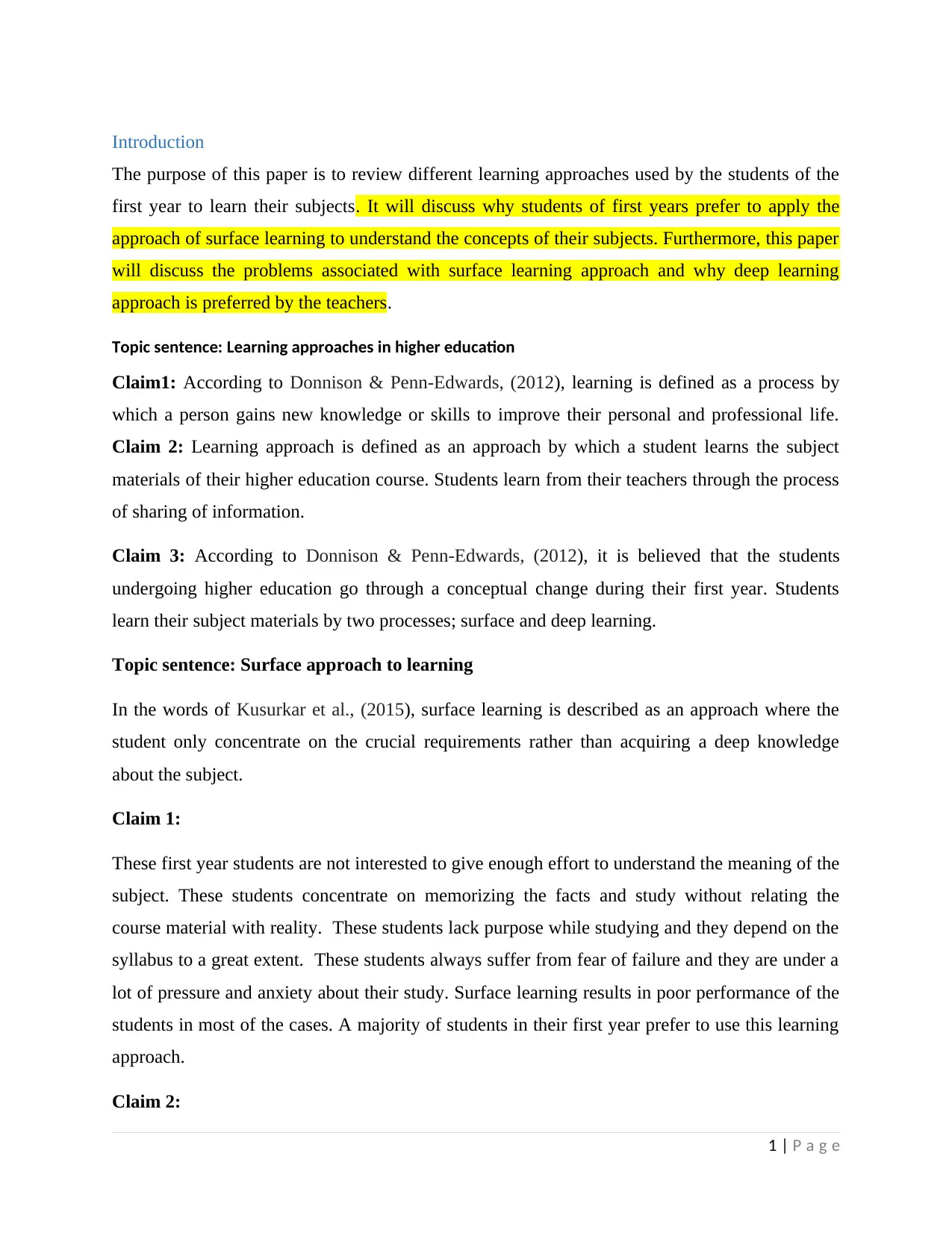
Introduction
The purpose of this paper is to review different learning approaches used by the students of the
first year to learn their subjects. It will discuss why students of first years prefer to apply the
approach of surface learning to understand the concepts of their subjects. Furthermore, this paper
will discuss the problems associated with surface learning approach and why deep learning
approach is preferred by the teachers.
Topic sentence: Learning approaches in higher education
Claim1: According to Donnison & Penn-Edwards, (2012), learning is defined as a process by
which a person gains new knowledge or skills to improve their personal and professional life.
Claim 2: Learning approach is defined as an approach by which a student learns the subject
materials of their higher education course. Students learn from their teachers through the process
of sharing of information.
Claim 3: According to Donnison & Penn-Edwards, (2012), it is believed that the students
undergoing higher education go through a conceptual change during their first year. Students
learn their subject materials by two processes; surface and deep learning.
Topic sentence: Surface approach to learning
In the words of Kusurkar et al., (2015), surface learning is described as an approach where the
student only concentrate on the crucial requirements rather than acquiring a deep knowledge
about the subject.
Claim 1:
These first year students are not interested to give enough effort to understand the meaning of the
subject. These students concentrate on memorizing the facts and study without relating the
course material with reality. These students lack purpose while studying and they depend on the
syllabus to a great extent. These students always suffer from fear of failure and they are under a
lot of pressure and anxiety about their study. Surface learning results in poor performance of the
students in most of the cases. A majority of students in their first year prefer to use this learning
approach.
Claim 2:
1 | P a g e
The purpose of this paper is to review different learning approaches used by the students of the
first year to learn their subjects. It will discuss why students of first years prefer to apply the
approach of surface learning to understand the concepts of their subjects. Furthermore, this paper
will discuss the problems associated with surface learning approach and why deep learning
approach is preferred by the teachers.
Topic sentence: Learning approaches in higher education
Claim1: According to Donnison & Penn-Edwards, (2012), learning is defined as a process by
which a person gains new knowledge or skills to improve their personal and professional life.
Claim 2: Learning approach is defined as an approach by which a student learns the subject
materials of their higher education course. Students learn from their teachers through the process
of sharing of information.
Claim 3: According to Donnison & Penn-Edwards, (2012), it is believed that the students
undergoing higher education go through a conceptual change during their first year. Students
learn their subject materials by two processes; surface and deep learning.
Topic sentence: Surface approach to learning
In the words of Kusurkar et al., (2015), surface learning is described as an approach where the
student only concentrate on the crucial requirements rather than acquiring a deep knowledge
about the subject.
Claim 1:
These first year students are not interested to give enough effort to understand the meaning of the
subject. These students concentrate on memorizing the facts and study without relating the
course material with reality. These students lack purpose while studying and they depend on the
syllabus to a great extent. These students always suffer from fear of failure and they are under a
lot of pressure and anxiety about their study. Surface learning results in poor performance of the
students in most of the cases. A majority of students in their first year prefer to use this learning
approach.
Claim 2:
1 | P a g e
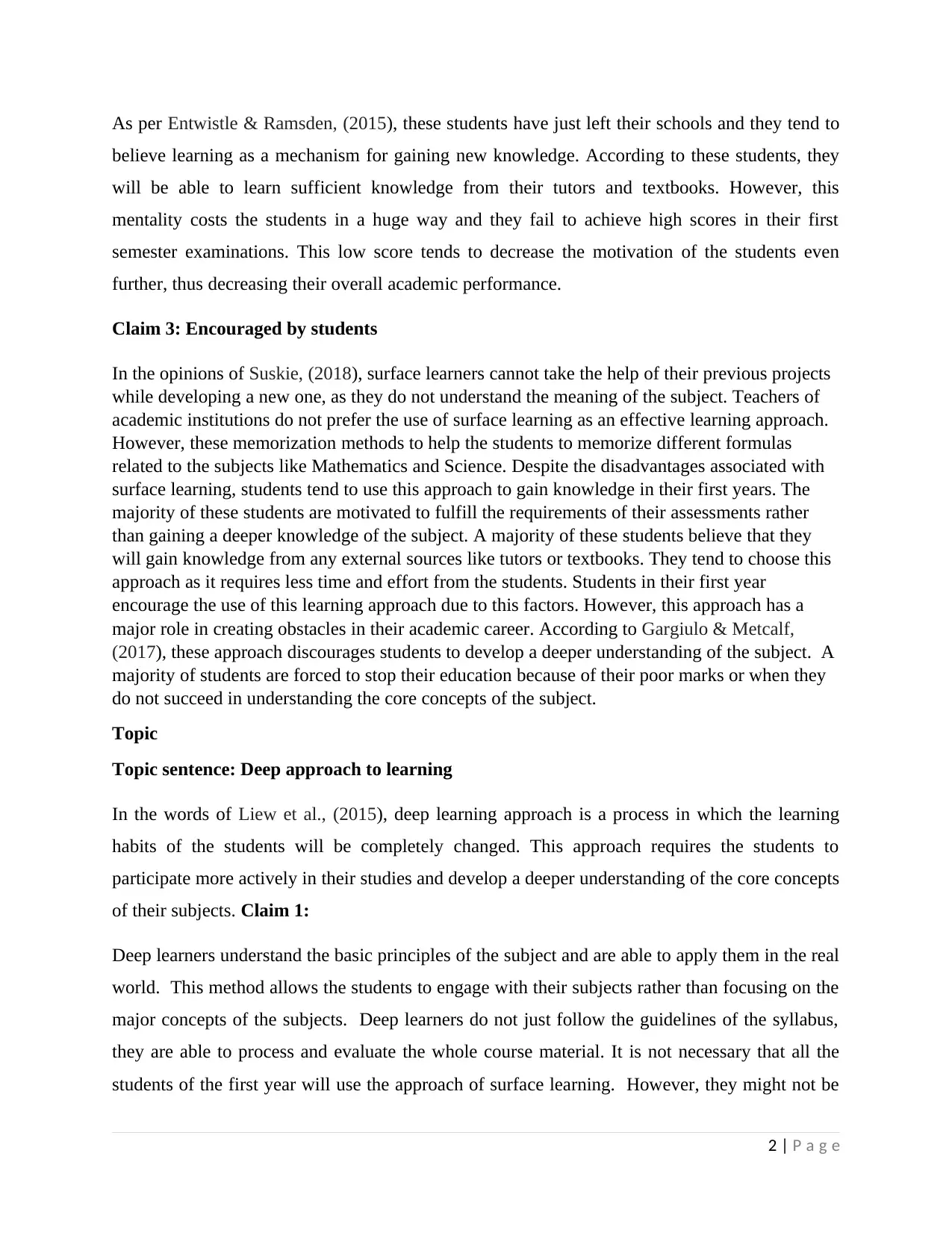
As per Entwistle & Ramsden, (2015), these students have just left their schools and they tend to
believe learning as a mechanism for gaining new knowledge. According to these students, they
will be able to learn sufficient knowledge from their tutors and textbooks. However, this
mentality costs the students in a huge way and they fail to achieve high scores in their first
semester examinations. This low score tends to decrease the motivation of the students even
further, thus decreasing their overall academic performance.
Claim 3: Encouraged by students
In the opinions of Suskie, (2018), surface learners cannot take the help of their previous projects
while developing a new one, as they do not understand the meaning of the subject. Teachers of
academic institutions do not prefer the use of surface learning as an effective learning approach.
However, these memorization methods to help the students to memorize different formulas
related to the subjects like Mathematics and Science. Despite the disadvantages associated with
surface learning, students tend to use this approach to gain knowledge in their first years. The
majority of these students are motivated to fulfill the requirements of their assessments rather
than gaining a deeper knowledge of the subject. A majority of these students believe that they
will gain knowledge from any external sources like tutors or textbooks. They tend to choose this
approach as it requires less time and effort from the students. Students in their first year
encourage the use of this learning approach due to this factors. However, this approach has a
major role in creating obstacles in their academic career. According to Gargiulo & Metcalf,
(2017), these approach discourages students to develop a deeper understanding of the subject. A
majority of students are forced to stop their education because of their poor marks or when they
do not succeed in understanding the core concepts of the subject.
Topic
Topic sentence: Deep approach to learning
In the words of Liew et al., (2015), deep learning approach is a process in which the learning
habits of the students will be completely changed. This approach requires the students to
participate more actively in their studies and develop a deeper understanding of the core concepts
of their subjects. Claim 1:
Deep learners understand the basic principles of the subject and are able to apply them in the real
world. This method allows the students to engage with their subjects rather than focusing on the
major concepts of the subjects. Deep learners do not just follow the guidelines of the syllabus,
they are able to process and evaluate the whole course material. It is not necessary that all the
students of the first year will use the approach of surface learning. However, they might not be
2 | P a g e
believe learning as a mechanism for gaining new knowledge. According to these students, they
will be able to learn sufficient knowledge from their tutors and textbooks. However, this
mentality costs the students in a huge way and they fail to achieve high scores in their first
semester examinations. This low score tends to decrease the motivation of the students even
further, thus decreasing their overall academic performance.
Claim 3: Encouraged by students
In the opinions of Suskie, (2018), surface learners cannot take the help of their previous projects
while developing a new one, as they do not understand the meaning of the subject. Teachers of
academic institutions do not prefer the use of surface learning as an effective learning approach.
However, these memorization methods to help the students to memorize different formulas
related to the subjects like Mathematics and Science. Despite the disadvantages associated with
surface learning, students tend to use this approach to gain knowledge in their first years. The
majority of these students are motivated to fulfill the requirements of their assessments rather
than gaining a deeper knowledge of the subject. A majority of these students believe that they
will gain knowledge from any external sources like tutors or textbooks. They tend to choose this
approach as it requires less time and effort from the students. Students in their first year
encourage the use of this learning approach due to this factors. However, this approach has a
major role in creating obstacles in their academic career. According to Gargiulo & Metcalf,
(2017), these approach discourages students to develop a deeper understanding of the subject. A
majority of students are forced to stop their education because of their poor marks or when they
do not succeed in understanding the core concepts of the subject.
Topic
Topic sentence: Deep approach to learning
In the words of Liew et al., (2015), deep learning approach is a process in which the learning
habits of the students will be completely changed. This approach requires the students to
participate more actively in their studies and develop a deeper understanding of the core concepts
of their subjects. Claim 1:
Deep learners understand the basic principles of the subject and are able to apply them in the real
world. This method allows the students to engage with their subjects rather than focusing on the
major concepts of the subjects. Deep learners do not just follow the guidelines of the syllabus,
they are able to process and evaluate the whole course material. It is not necessary that all the
students of the first year will use the approach of surface learning. However, they might not be
2 | P a g e
⊘ This is a preview!⊘
Do you want full access?
Subscribe today to unlock all pages.

Trusted by 1+ million students worldwide
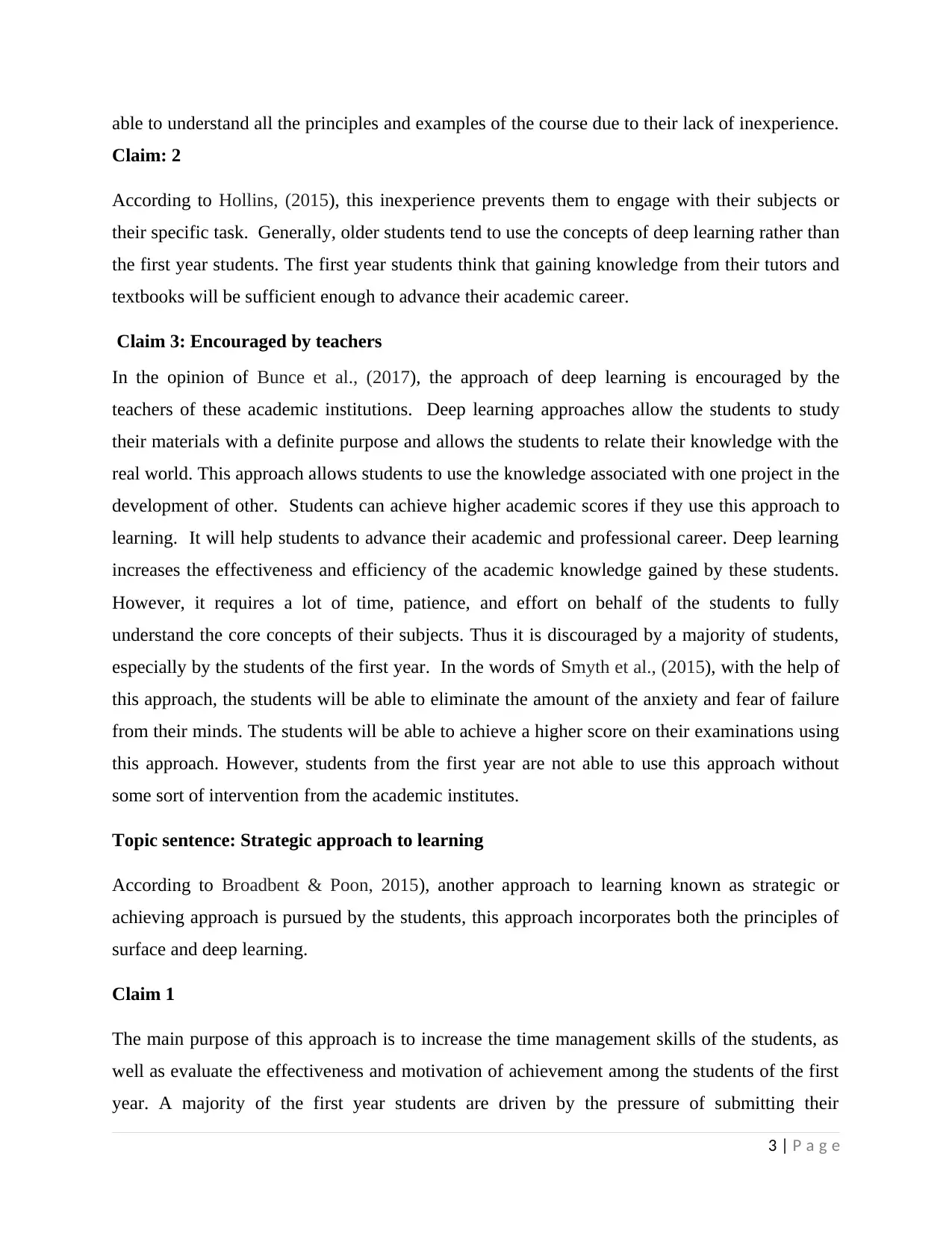
able to understand all the principles and examples of the course due to their lack of inexperience.
Claim: 2
According to Hollins, (2015), this inexperience prevents them to engage with their subjects or
their specific task. Generally, older students tend to use the concepts of deep learning rather than
the first year students. The first year students think that gaining knowledge from their tutors and
textbooks will be sufficient enough to advance their academic career.
Claim 3: Encouraged by teachers
In the opinion of Bunce et al., (2017), the approach of deep learning is encouraged by the
teachers of these academic institutions. Deep learning approaches allow the students to study
their materials with a definite purpose and allows the students to relate their knowledge with the
real world. This approach allows students to use the knowledge associated with one project in the
development of other. Students can achieve higher academic scores if they use this approach to
learning. It will help students to advance their academic and professional career. Deep learning
increases the effectiveness and efficiency of the academic knowledge gained by these students.
However, it requires a lot of time, patience, and effort on behalf of the students to fully
understand the core concepts of their subjects. Thus it is discouraged by a majority of students,
especially by the students of the first year. In the words of Smyth et al., (2015), with the help of
this approach, the students will be able to eliminate the amount of the anxiety and fear of failure
from their minds. The students will be able to achieve a higher score on their examinations using
this approach. However, students from the first year are not able to use this approach without
some sort of intervention from the academic institutes.
Topic sentence: Strategic approach to learning
According to Broadbent & Poon, 2015), another approach to learning known as strategic or
achieving approach is pursued by the students, this approach incorporates both the principles of
surface and deep learning.
Claim 1
The main purpose of this approach is to increase the time management skills of the students, as
well as evaluate the effectiveness and motivation of achievement among the students of the first
year. A majority of the first year students are driven by the pressure of submitting their
3 | P a g e
Claim: 2
According to Hollins, (2015), this inexperience prevents them to engage with their subjects or
their specific task. Generally, older students tend to use the concepts of deep learning rather than
the first year students. The first year students think that gaining knowledge from their tutors and
textbooks will be sufficient enough to advance their academic career.
Claim 3: Encouraged by teachers
In the opinion of Bunce et al., (2017), the approach of deep learning is encouraged by the
teachers of these academic institutions. Deep learning approaches allow the students to study
their materials with a definite purpose and allows the students to relate their knowledge with the
real world. This approach allows students to use the knowledge associated with one project in the
development of other. Students can achieve higher academic scores if they use this approach to
learning. It will help students to advance their academic and professional career. Deep learning
increases the effectiveness and efficiency of the academic knowledge gained by these students.
However, it requires a lot of time, patience, and effort on behalf of the students to fully
understand the core concepts of their subjects. Thus it is discouraged by a majority of students,
especially by the students of the first year. In the words of Smyth et al., (2015), with the help of
this approach, the students will be able to eliminate the amount of the anxiety and fear of failure
from their minds. The students will be able to achieve a higher score on their examinations using
this approach. However, students from the first year are not able to use this approach without
some sort of intervention from the academic institutes.
Topic sentence: Strategic approach to learning
According to Broadbent & Poon, 2015), another approach to learning known as strategic or
achieving approach is pursued by the students, this approach incorporates both the principles of
surface and deep learning.
Claim 1
The main purpose of this approach is to increase the time management skills of the students, as
well as evaluate the effectiveness and motivation of achievement among the students of the first
year. A majority of the first year students are driven by the pressure of submitting their
3 | P a g e
Paraphrase This Document
Need a fresh take? Get an instant paraphrase of this document with our AI Paraphraser
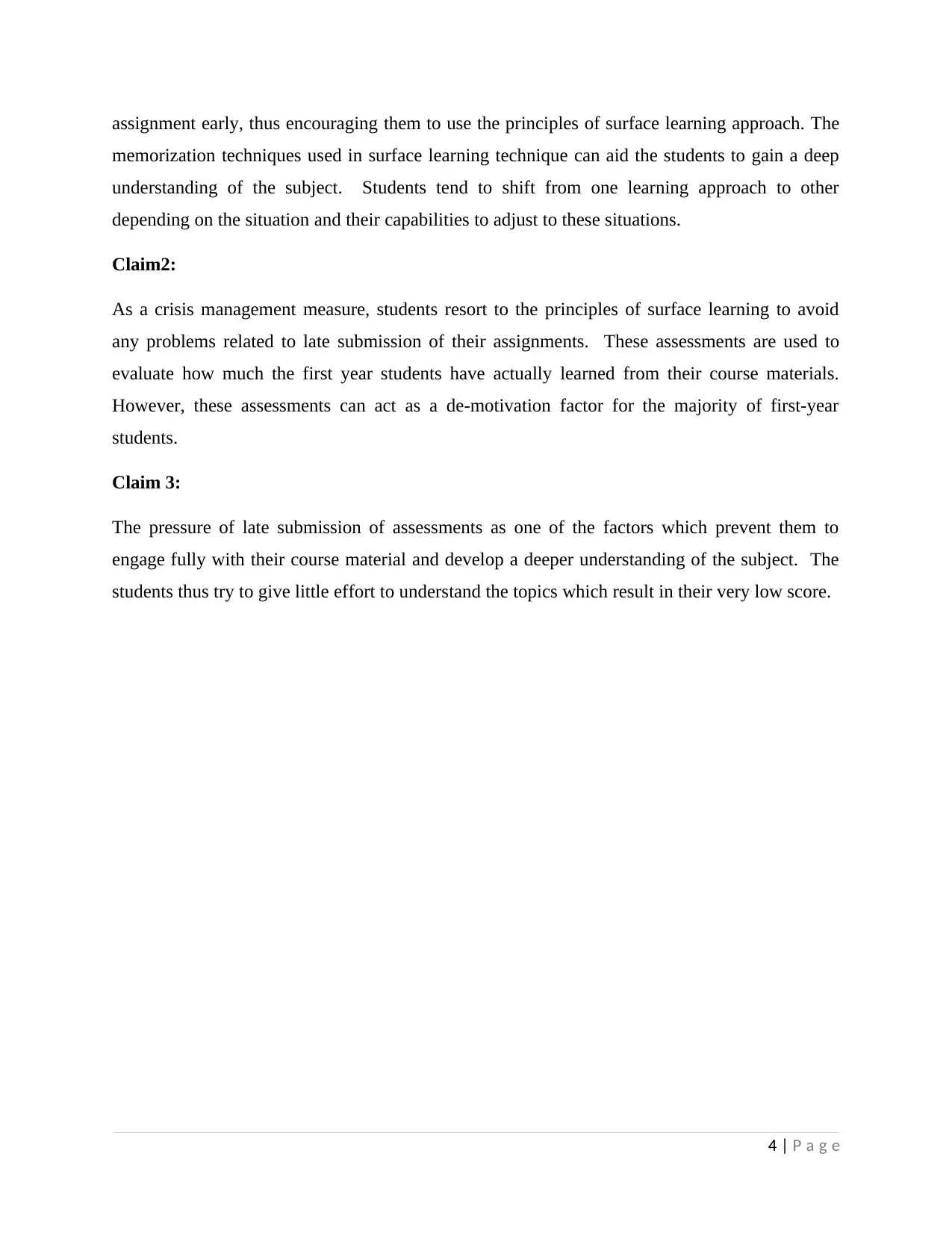
assignment early, thus encouraging them to use the principles of surface learning approach. The
memorization techniques used in surface learning technique can aid the students to gain a deep
understanding of the subject. Students tend to shift from one learning approach to other
depending on the situation and their capabilities to adjust to these situations.
Claim2:
As a crisis management measure, students resort to the principles of surface learning to avoid
any problems related to late submission of their assignments. These assessments are used to
evaluate how much the first year students have actually learned from their course materials.
However, these assessments can act as a de-motivation factor for the majority of first-year
students.
Claim 3:
The pressure of late submission of assessments as one of the factors which prevent them to
engage fully with their course material and develop a deeper understanding of the subject. The
students thus try to give little effort to understand the topics which result in their very low score.
4 | P a g e
memorization techniques used in surface learning technique can aid the students to gain a deep
understanding of the subject. Students tend to shift from one learning approach to other
depending on the situation and their capabilities to adjust to these situations.
Claim2:
As a crisis management measure, students resort to the principles of surface learning to avoid
any problems related to late submission of their assignments. These assessments are used to
evaluate how much the first year students have actually learned from their course materials.
However, these assessments can act as a de-motivation factor for the majority of first-year
students.
Claim 3:
The pressure of late submission of assessments as one of the factors which prevent them to
engage fully with their course material and develop a deeper understanding of the subject. The
students thus try to give little effort to understand the topics which result in their very low score.
4 | P a g e
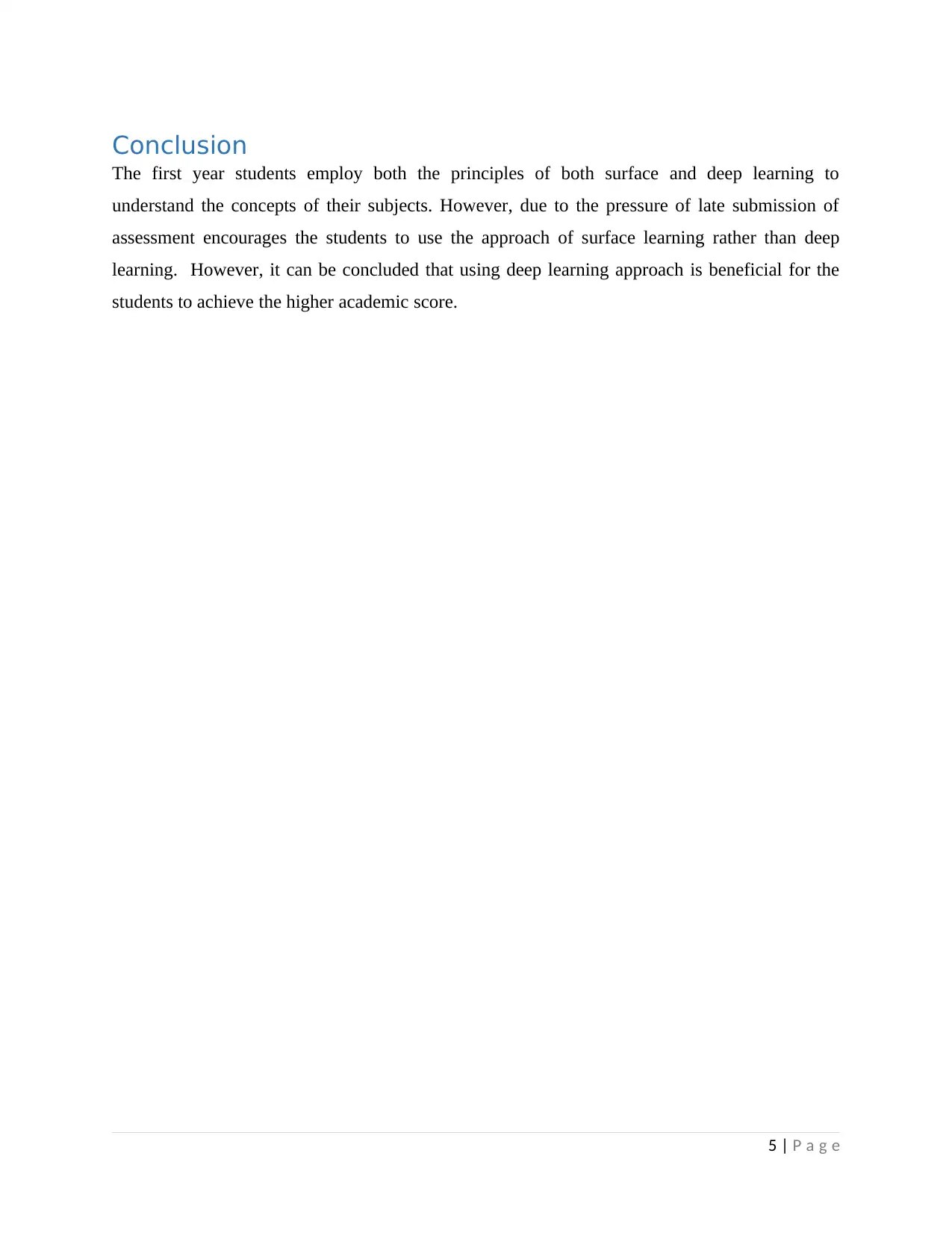
Conclusion
The first year students employ both the principles of both surface and deep learning to
understand the concepts of their subjects. However, due to the pressure of late submission of
assessment encourages the students to use the approach of surface learning rather than deep
learning. However, it can be concluded that using deep learning approach is beneficial for the
students to achieve the higher academic score.
5 | P a g e
The first year students employ both the principles of both surface and deep learning to
understand the concepts of their subjects. However, due to the pressure of late submission of
assessment encourages the students to use the approach of surface learning rather than deep
learning. However, it can be concluded that using deep learning approach is beneficial for the
students to achieve the higher academic score.
5 | P a g e
⊘ This is a preview!⊘
Do you want full access?
Subscribe today to unlock all pages.

Trusted by 1+ million students worldwide

References
Broadbent, J., & Poon, W. L. (2015). Self-regulated learning strategies & academic achievement
in online higher education learning environments: A systematic review. The Internet and
Higher Education, 27, 1-13.
Bunce, L., Baird, A., & Jones, S. E. (2017). The student-as-consumer approach in higher
education and its effects on academic performance. Studies in Higher Education, 42(11),
1958-1978.
Donnison, S., & Penn-Edwards, S. (2012). Focusing on first year assessment: Surface or deep
approaches to learning?. The International Journal of the First Year in Higher
Education, 3(2), 9.
Entwistle, N., & Ramsden, P. (2015). Understanding student learning (Routledge revivals).
Routledge.
Gargiulo, R. M., & Metcalf, D. (2017). Teaching in Today s Inclusive Classrooms: A Universal
Design for Learning Approach. Nelson Education.
Hollins, E. R. (2015). Culture in school learning: Revealing the deep meaning. Routledge.
Kusurkar, R. A., Artino, A. R., & Ten Cate, T. J. (2015). Motivation and Learning. The Art of
Teaching Medical Students-E-Book, 62.
Liew, S. C., Sidhu, J., & Barua, A. (2015). The relationship between learning preferences (styles
and approaches) and learning outcomes among pre-clinical undergraduate medical
students. BMC medical education, 15(1), 44.
Smyth, L., Mavor, K. I., Platow, M. J., Grace, D. M., & Reynolds, K. J. (2015). Discipline social
identification, study norms and learning approach in university students. Educational
Psychology, 35(1), 53-72.
Suskie, L. (2018). Assessing student learning: A common sense guide. John Wiley & Sons.
6 | P a g e
Broadbent, J., & Poon, W. L. (2015). Self-regulated learning strategies & academic achievement
in online higher education learning environments: A systematic review. The Internet and
Higher Education, 27, 1-13.
Bunce, L., Baird, A., & Jones, S. E. (2017). The student-as-consumer approach in higher
education and its effects on academic performance. Studies in Higher Education, 42(11),
1958-1978.
Donnison, S., & Penn-Edwards, S. (2012). Focusing on first year assessment: Surface or deep
approaches to learning?. The International Journal of the First Year in Higher
Education, 3(2), 9.
Entwistle, N., & Ramsden, P. (2015). Understanding student learning (Routledge revivals).
Routledge.
Gargiulo, R. M., & Metcalf, D. (2017). Teaching in Today s Inclusive Classrooms: A Universal
Design for Learning Approach. Nelson Education.
Hollins, E. R. (2015). Culture in school learning: Revealing the deep meaning. Routledge.
Kusurkar, R. A., Artino, A. R., & Ten Cate, T. J. (2015). Motivation and Learning. The Art of
Teaching Medical Students-E-Book, 62.
Liew, S. C., Sidhu, J., & Barua, A. (2015). The relationship between learning preferences (styles
and approaches) and learning outcomes among pre-clinical undergraduate medical
students. BMC medical education, 15(1), 44.
Smyth, L., Mavor, K. I., Platow, M. J., Grace, D. M., & Reynolds, K. J. (2015). Discipline social
identification, study norms and learning approach in university students. Educational
Psychology, 35(1), 53-72.
Suskie, L. (2018). Assessing student learning: A common sense guide. John Wiley & Sons.
6 | P a g e
1 out of 7
Related Documents
Your All-in-One AI-Powered Toolkit for Academic Success.
+13062052269
info@desklib.com
Available 24*7 on WhatsApp / Email
![[object Object]](/_next/static/media/star-bottom.7253800d.svg)
Unlock your academic potential
© 2024 | Zucol Services PVT LTD | All rights reserved.




